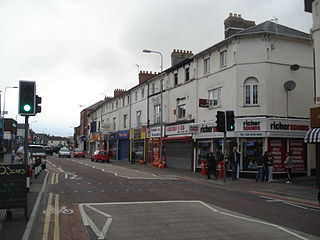
Roath is a district and community to the north-east of the city centre of Cardiff, capital of Wales. The area is mostly covered by the Plasnewydd electoral ward, and stretches from Adamsdown in the south to Roath Park in the north.

Splott is a district and community in the south of the city of Cardiff, capital of Wales, just east of the city centre. It was built up in the late 19th century on the land of two farms of the same name: Upper Splott and Lower Splott Farms. Splott is characterised by its once vast steelworks and rows of tightly knit terraced houses. The suburb of Splott falls into the Splott electoral ward.

Lisvane is a community in the north of Cardiff, the capital of Wales, located 5 miles (8 km) north of the city centre. Lisvane is generally considered to be one of the wealthiest residential areas of Wales, with many properties worth in excess of £1 million. Lisvane had 3,319 residents in 2001 and comprises approximately 1,700 dwellings, a local village shop, primary school, community cabin library, park, nursery, parish church, public house, war memorial, Scout hall and community or village hall.

Canton is an inner-city district and community in the west of Cardiff, capital of Wales, lying 2 miles (3.2 km) west of the city's civic centre. It is located adjecent to Pontcanna, Cardiff. Canton is one of the most ethnically diverse of Cardiff's suburbs, with a significant Pakistani and Indian population. The total population of Canton increased to 14,304 at the 2011 census. It is also the most Welsh-speaking district of central Cardiff, with 19.1% of the population speaking Welsh.

Taff's Well is a semi-rural village, community and electoral ward located at the south easterly tip of Rhondda Cynon Taf, 6 miles (9.7 km) to the north of Cardiff, the capital city of Wales. Known locally as the 'Gates to the Valleys', it is separated from Gwaelod-y-Garth by the River Taff. Taff's Well is distinguished because it contains the only thermal spring in Wales. The tepid water is thought to rise along a fault-line from the Carboniferous Limestone, in somewhat similar manner to the warm springs at Bristol and Bath. Various religious groups regard it as a spiritual site.

St Margaret's Church is a nineteenth-century Church in Wales parish church in the suburb of Roath, Cardiff, Wales. It includes the mausoleum of the Marquises of Bute.

Habershon & Fawckner or Habershon, Pite & Fawckner was a British architectural practice active in England and Wales from the 1860s, particularly in Cardiff and the South Wales area. They had had offices in London, Cardiff and Newport, designing a large number of houses, villas and non-conformist chapels.
Tredegarville was the name given to an upper class area of streets and villas in Cardiff, Wales, developed during the second half of the 19th century. The area is now part of Roath.

St Edward's Church is a Church in Wales church in Penylan, Cardiff, South Wales. It is a daughter church of St Margaret's Church, Roath, the only one remaining in use after the closure of St Anne's in 2015.

Parkminster United Reformed Church is located in Roath, Cardiff.

The Church of St Andrew and St Teilo is a Church in Wales church, located in Cathays, Cardiff. In 2020 the church was relaunched as Citizen Church, with a mission to serve students and young professionals.

St. Andrew's United Reformed Church is a 19th-century United Reformed church located in the Roath area of Cardiff, Wales. The church is situated on the corner of Wellfield Road and Malborough Road, with some referring to it as the 'church on the corner'. The church covers the ministry areas of Roath and Penylan.

St Saviour's Church is a Church in Wales church in Splott, Cardiff, South Wales.

St Anne's Church, Roath is a disused church on the corner of Snipe Street and Croft Street, in Roath, Cardiff, Wales. It closed in 2015 after 128 years of worship.

St Peter's Church, Roath is the oldest surviving Roman Catholic church in Cardiff, the capital of Wales. It is administered by the Rosminians.

Llanishen Methodist Church, also known as Century Chapel, is a listed place of worship in Llanishen, a suburb of Cardiff in Wales.

Tredegarville Baptist Church is a Baptist chapel in the suburb of Roath, Cardiff. It was established to reach Roman Catholics with the Gospel.

Trinity Methodist Church, now the Trinity Centre, is a Grade II listed former Methodist church in Adamsdown, Cardiff, Wales.

Tabernacle is a listed place of worship in the suburb of Roath, Cardiff, Wales.



















